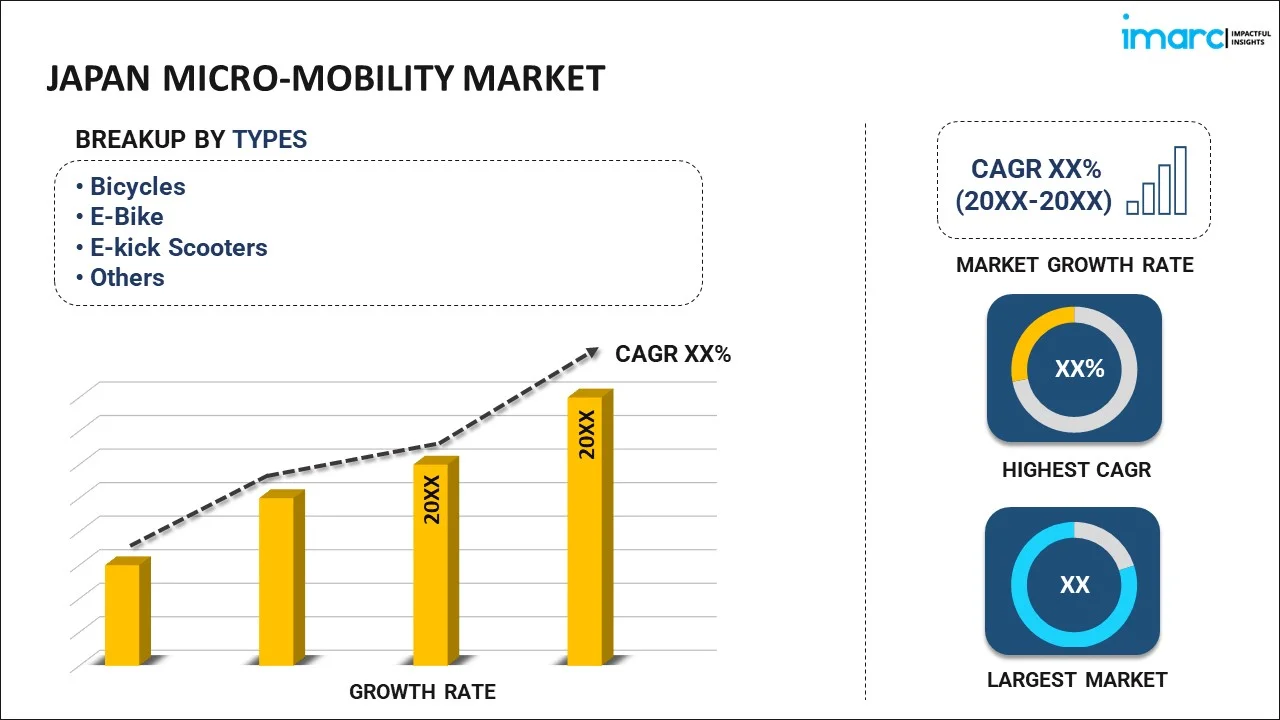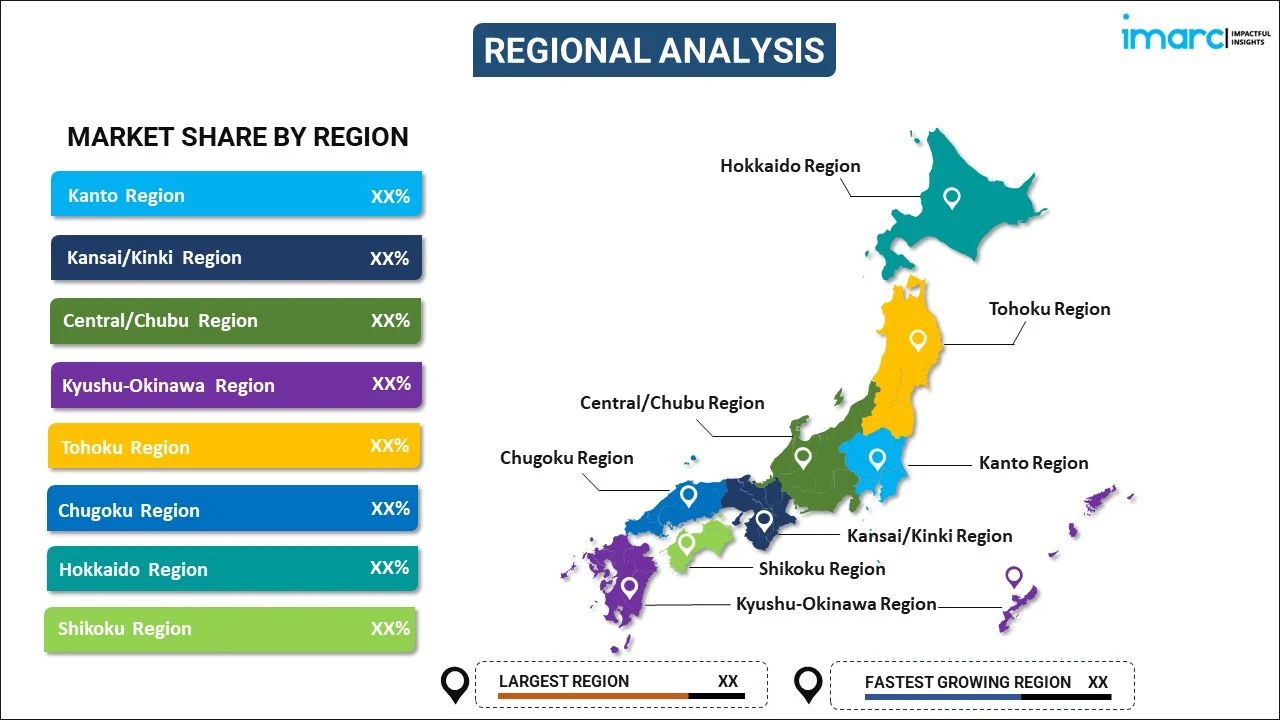
Japan Micro-Mobility Market Report by Type (Bicycles, E-Bike, E-kick Scooters, and Others), Propulsion Type (Manual, Electrically-Powered, Hybrid), Sharing Type (Docked, Dock-Less), Speed (Less Than 25 Kmph, Above 25 Kmph), Age Group (15-34, 35-54, 55 and Above), Ownership (Business-To-Business, Business-To-Consumer), and Region 2025-2033
Market Overview:
Japan micro-mobility market size reached USD 3.8 Billion in 2024. Looking forward, IMARC Group expects the market to reach USD 13.9 Billion by 2033, exhibiting a growth rate (CAGR) of 15.5% during 2025-2033. The increasing advances in battery technology and the development of efficient electric motors, which have made it easier to manufacture and operate electric scooters, e-bikes, and other micro-mobility vehicles, are driving the market.
|
Report Attribute
|
Key Statistics
|
|---|---|
|
Base Year
|
2024 |
|
Forecast Years
|
2025-2033 |
|
Historical Years
|
2019-2024
|
| Market Size in 2024 | USD 3.8 Billion |
| Market Forecast in 2033 | USD 13.9 Billion |
| Market Growth Rate (2025-2033) | 15.5% |
Micro-mobility refers to the integration of small, lightweight transportation options into urban transport networks designed to cover short distances and provide last-mile connectivity. Typically powered by electric motors, these vehicles include e-scooters, e-bikes, and other compact personal transport devices. The rise of micro-mobility is driven by the increasing need for sustainable, efficient, and congestion-reducing transportation alternatives in crowded urban areas. These services often operate on a share-based model, allowing users to rent vehicles through smartphone applications, contributing to the ease of access and flexibility in urban commuting. Micro-mobility solutions address gaps in traditional public transportation systems, providing a convenient option for short trips that might be too long to walk but too short to drive. By reducing reliance on personal automobiles for short distances, micro-mobility can significantly decrease traffic congestion, lower greenhouse gas emissions, and contribute to improved air quality. Furthermore, it promotes active transportation, potentially leading to health benefits for users.
Japan Micro-Mobility Market Trends:
The micro-mobility market in Japan is witnessing unprecedented growth, driven by several key factors. Firstly, urbanization is on the rise, and with it, the need for efficient, eco-friendly transportation solutions. Consequently, city dwellers are increasingly turning to micro-mobility options, such as electric scooters and bikes, as viable alternatives to traditional cars, alleviating traffic congestion and reducing carbon emissions. Furthermore, the widespread adoption of smartphone technology has played a pivotal role in the expansion of this market. Seamless connectivity and user-friendly mobile apps have made it easier than ever for individuals to locate, unlock, and pay for micro-mobility services, fostering convenience and accessibility. Additionally, the growing awareness of environmental sustainability is propelling the market forward as more consumers seek eco-conscious modes of transportation. Moreover, regulatory support and initiatives from local governments are bolstering the micro-mobility sector. Favorable policies, infrastructure development, and partnerships with micro-mobility providers are creating an enabling environment for growth. In conclusion, the micro-mobility market in Japan is being propelled by a confluence of factors, including urbanization, technological advancements, environmental consciousness, and government support.
Japan Micro-Mobility Market Segmentation:
IMARC Group provides an analysis of the key trends in each segment of the market, along with forecasts at the country level for 2025-2033. Our report has categorized the market based on type, propulsion type, sharing type, speed, age group, and ownership.
Type Insights:

- Bicycles
- E-Bike
- E-kick Scooters
- Others
The report has provided a detailed breakup and analysis of the market based on the type. This includes bicycles, E-bike, E-kick scooters, and others.
Propulsion Type Insights:
- Manual
- Electrically-Powered
- Hybrid
A detailed breakup and analysis of the market based on the propulsion type have also been provided in the report. This includes manual, electrically-powered, and hybrid.
Sharing Type Insights:
- Docked
- Dock-Less
The report has provided a detailed breakup and analysis of the market based on the sharing type. This includes docked and dock-less.
Speed Insights:
- Less Than 25 Kmph
- Above 25 Kmph
A detailed breakup and analysis of the market based on the speed have also been provided in the report. This includes less than 25 kmph and above 25 kmph.
Age Group Insights:
- 15-34
- 35-54
- 55 and Above
The report has provided a detailed breakup and analysis of the market based on age group. This includes 15-34, 35-54, and 55 and above.
Ownership Insights:
- Business-To-Business
- Business-To-Consumer
A detailed breakup and analysis of the market based on the ownership have also been provided in the report. This includes business-to-business and business-to-consumer.
Regional Insights:

- Kanto Region
- Kansai/Kinki Region
- Central/ Chubu Region
- Kyushu-Okinawa Region
- Tohoku Region
- Chugoku Region
- Hokkaido Region
- Shikoku Region
The report has also provided a comprehensive analysis of all the major regional markets, which include Kanto Region, Kansai/Kinki Region, Central/ Chubu Region, Kyushu-Okinawa Region, Tohoku Region, Chugoku Region, Hokkaido Region, and Shikoku Region.
Competitive Landscape:
The market research report has also provided a comprehensive analysis of the competitive landscape. Competitive analysis such as market structure, key player positioning, top winning strategies, competitive dashboard, and company evaluation quadrant has been covered in the report. Also, detailed profiles of all major companies have been provided.
Japan Micro-Mobility Market Report Coverage:
| Report Features | Details |
|---|---|
| Base Year of the Analysis | 2024 |
| Historical Period | 2019-2024 |
| Forecast Period | 2025-2033 |
| Units | Billion USD |
| Scope of the Report | Exploration of Historical Trends and Market Outlook, Industry Catalysts and Challenges, Segment-Wise Historical and Future Market Assessment:
|
| Types Covered | Bicycles, E-Bike, E-kick Scooters, Others |
| Propulsion Types Covered | Manual, Electrically-Powered, Hybrid |
| Sharing Types Covered | Docked, Dock-Less |
| Speeds Covered | Less Than 25 Kmph, Above 25 Kmph |
| Age Groups Covered | 15-34, 35-54, 55 and Above |
| Ownerships Covered | Business-To-Business, Business-To-Consumer |
| Regions Covered | Kanto Region, Kansai/Kinki Region, Central/ Chubu Region, Kyushu-Okinawa Region, Tohoku Region, Chugoku Region, Hokkaido Region, Shikoku Region |
| Customization Scope | 10% Free Customization |
| Post-Sale Analyst Support | 10-12 Weeks |
| Delivery Format | PDF and Excel through Email (We can also provide the editable version of the report in PPT/Word format on special request) |
Key Questions Answered in This Report:
- How has the Japan micro-mobility market performed so far and how will it perform in the coming years?
- What has been the impact of COVID-19 on the Japan micro-mobility market?
- What is the breakup of the Japan micro-mobility market on the basis of type?
- What is the breakup of the Japan micro-mobility market on the basis of propulsion type?
- What is the breakup of the Japan micro-mobility market on the basis of sharing type?
- What is the breakup of the Japan micro-mobility market on the basis of speed?
- What is the breakup of the Japan micro-mobility market on the basis of age group?
- What is the breakup of the Japan micro-mobility market on the basis of ownership?
- What are the various stages in the value chain of the Japan micro-mobility market?
- What are the key driving factors and challenges in the Japan micro-mobility?
- What is the structure of the Japan micro-mobility market and who are the key players?
- What is the degree of competition in the Japan micro-mobility market?
Key Benefits for Stakeholders:
- IMARC’s industry report offers a comprehensive quantitative analysis of various market segments, historical and current market trends, market forecasts, and dynamics of the Japan micro-mobility market from 2019-2033.
- The research report provides the latest information on the market drivers, challenges, and opportunities in the Japan micro-mobility market.
- Porter's five forces analysis assist stakeholders in assessing the impact of new entrants, competitive rivalry, supplier power, buyer power, and the threat of substitution. It helps stakeholders to analyze the level of competition within the Japan micro-mobility industry and its attractiveness.
- Competitive landscape allows stakeholders to understand their competitive environment and provides an insight into the current positions of key players in the market.
Need more help?
- Speak to our experienced analysts for insights on the current market scenarios.
- Include additional segments and countries to customize the report as per your requirement.
- Gain an unparalleled competitive advantage in your domain by understanding how to utilize the report and positively impacting your operations and revenue.
- For further assistance, please connect with our analysts.
 Inquire Before Buying
Inquire Before Buying
 Speak to an Analyst
Speak to an Analyst
 Request Brochure
Request Brochure
 Request Customization
Request Customization




.webp)




.webp)












